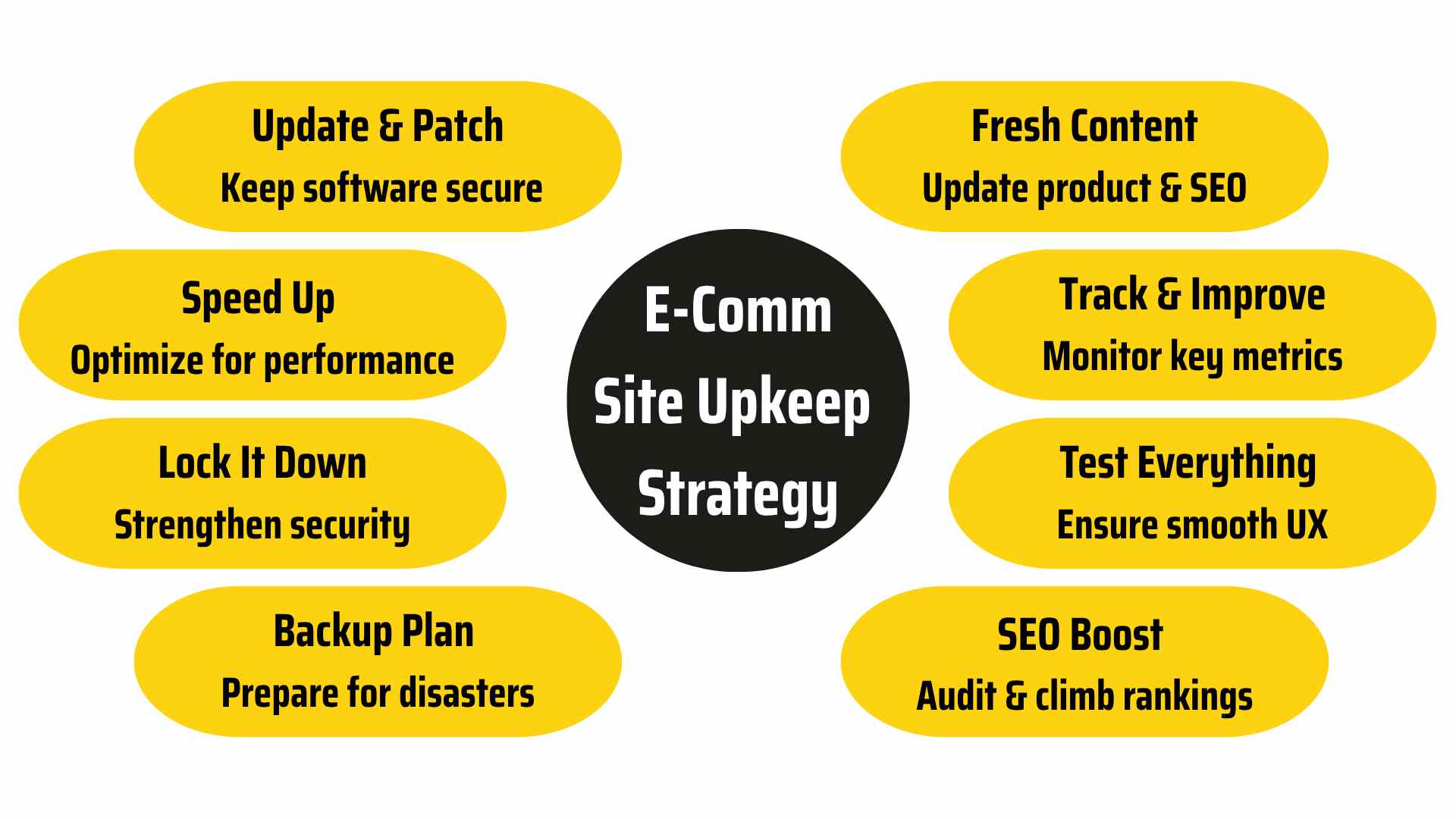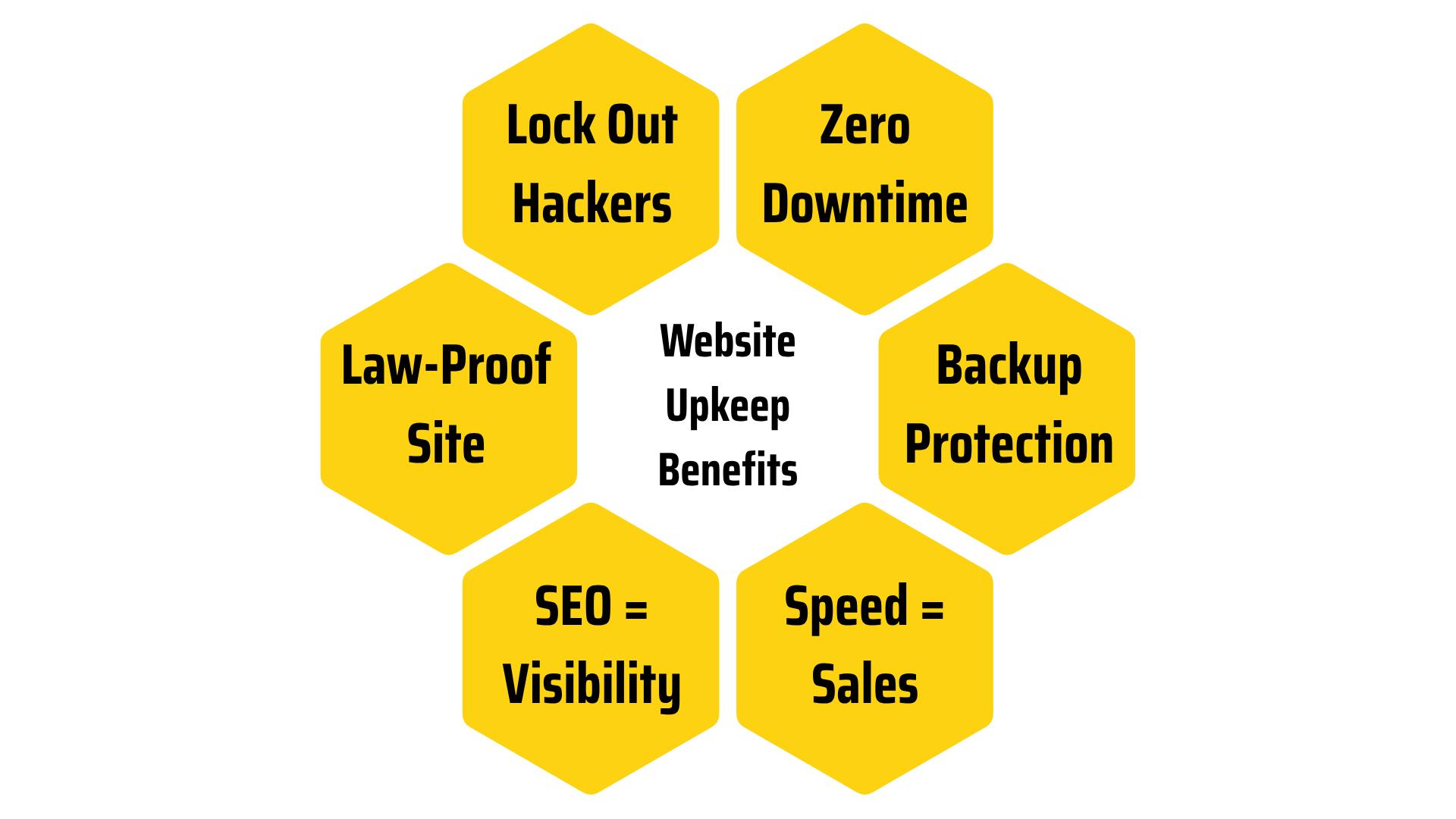Broken pages break brands and trust (of around 3B people).
It’s the last thing you want when people visit your online store.
Running an e-commerce site can be like a 24/7/365 job. It helps you
- Sell
- Connect with customers and
- Grow your business
But just like anything, your site needs care, too. If you don’t keep it in shape, things fall apart. Slow loading. Errors. And lost sales.
Hence, maintenance matters. It keeps everything smooth, safe, and visitor-friendly. And this helps your site run better, rank higher, and stay secure.
Result: More Conversion. More Sales.
There are around 2.7 billion consumers who shop online. (DemandSage)
So, to stay ahead and attract them, you need the right maintenance strategies like
- Regular updates
- Fixing broken links
- Monitoring performance
Effective E-commerce Website Maintenance Strategy
Software Updates and Security Patching
Old software is risky.
Update your
- CMS (like WordPress)
- Plugins
- Themes and
- Anything else with a version number
Developers push updates as they work to
- Fix bugs and
- Seal security holes
Delaying these updates makes your eCommerce site a sitting duck.
It’s wise to automate updates when possible. But always back up first, just in case.
Performance Optimization
Slow sites are deal-breakers.
- Compress and optimize your images
- Minify HTTP, CSS, and JavaScript
- Reduce redirects
- Enable caching
- Use lazy loading
Make the most of a CDN like Cloudflare. This helps deliver content faster across the globe.
All these tricks will work to optimize your e-commerce website and speed it up.
Robust Security
Passwords like “123456” belong in the trash.
- Use strong passwords and 2FA (two-factor authentication)
- Install a firewall
- Add malware scanners and SSL certificates
Tools like Sucuri and Wordfence scan your site regularly.
Because no customer will trust a site that shows the dreaded “Not Secure” warning.
Data Backups and Disaster Recovery
Things go wrong. Be ready.
- Set up daily or weekly automated backups
- Store them off-site. Try cloud storage or backup services
- Test your restore process now and then
Because a backup is only helpful if it actually works when things break.
Content Management
“Out of Stock” on an available product? Bad sign.
- Keep product listings updated
- Change prices
- Add new photos
- Refresh blogs
Outdated content hurts your SEO. This results in confusing your buyers.
Through these changes, make your site feel fresh every time someone visits.
Analytics and Monitoring
Guesswork! That’s a bad business plan.
Use tools like
- Google Analytics
- Hotjar
- Mixpanel
They let you see what’s working and what’s causing trouble.
Give these metrics a regular check
- Bounce rates
- Cart abandonment
- Conversion rates
This data helps you fine-tune your design, copy, and checkout process.
Testing
Not a single visitor wants checkout to feel like an obstacle course.
Test it all. Be it
- Buttons
- Search bars
- Filters
- Payment gateways
Focus the sites on both mobile and desktop.
Do test orders. Try broken promo codes.
If you catch it, your customers won’t have to.
SEO Audits
Search engines need reminders that your site exists.
Use SEO tools. For instance, Ahrefs or Semrush.
They all run monthly audits.
- Find broken links
- Optimize titles and images
- Update meta descriptions
- Keep up with Google’s ever-changing rules
All these will help boost the SEO rankings of your website. This will fuel your visibility, traffic, conversion, and sales.
How To Create An E-Commerce Website Maintenance Schedule
Daily
Start the day right. Check if your site is live.
Review backups. Confirm new orders and form submissions went through.
Bi-Weekly
Keep things fresh.
Update plugins and themes. Test how your site looks on mobile. Review page speed with tools like GTmetrix or PageSpeed Insights.
Monthly
Take a deep dive. Audit the full site
- SEO
- Performance
- Security
- Functionality
Test checkout flows. Analyze Google Analytics. Update blogs, FAQs, and homepage banners.
Annually
Delete the old.
Renew your domain name and SSL certificate. Review and update your privacy policy.
Consider upgrades or redesigns to make the site look new and inviting.
Map out your next year.
Why Is E-Commerce Website Maintenance Important?
Boosts Security
You know what hackers love? Old websites.
Outdated plugins and themes are like open doors to cyber attackers. And they don’t knock before entering.
Sadly, 30,000 websites regularly face hacks. And 95% of data breaches happen because of human errors. Outdated websites are one of those mistakes.
E-commerce sites store countless essential data points. Credit card info. Addresses. Order history. Personal details. That’s a gold mine for the hackers.
But keeping your site updated protects you from those issues.
You get the latest security updates. Your SSL stays active. Data gets encrypted. And malware doesn’t stand a chance.
Platforms like WooCommerce or Shopify push regular updates for that.
Maximizes Uptime
Would you like a website that disappears during checkout? Surely not.
Downtime means lost money. Gartner mentions that the “average cost of IT downtime is $5,000/minute.” That’s $300k an hour!
Now, if that downtime happens during a flash sale or the holiday, this will definitely lead to negative ROIs. You don’t want that, right?
E-commerce website maintenance helps you spot server issues. Plus, it keeps servers running, plugins updated, and errors in check.
You can avoid the “Sorry, we’re closed” message that drives customers straight to your enemies.
Regular monitoring tools like SiteWatch or Pingdom can keep you informed 24/7. That way, you can maximize uptime.
Prevents Data Loss
One bad update and poof. Your data is gone.
Products, customer orders, reviews, and all the hard-earned 5-star ratings can vanish without backups. This mostly originates from server crashes, plugin conflicts, and human error.
That’s scary for any e-commerce business owners. Some even have the worst.
As per Newsfile, “93% of companies that experience prolonged data loss go bankrupt.”
That’s why regular backups matter. And e-commerce website upkeep ensures that.
Tools like JetPack or BackupBuddy work great in this case. They have scheduled (daily or weekly) automated backups for data protection and recovery.
So, if something goes wrong, you don’t cry. Because the web maintenance (the backup system) helps you restore.
Enhances User Experience
Clunky sites kill conversions.
Your customers want
- Fast loading,
- Smooth navigation and
- Zero hiccups during checkout
Google says,
“53% of mobile users leave a site that takes longer than 3 seconds to load.” 3 seconds! That’s barely enough time to sneeze.
Regular e-commerce website maintenance offers faster load times. It lets you
- Clean broken links
- Fix slow-loading pages
- Test site functionality and
- Check how your site works on mobile
This leads to improved website speed, higher customer satisfaction, and increased conversion rates. Because,
“A well-maintained website can get up to 40% more visitors.” (Webstix)
Improves Search Engine Ranking
Google hates lazy websites.
It wants fast, clean, and secure pages. If yours is full of errors, we mean,
- Site loads slowly
- Has broken links or
- Outdated sitemaps
Your rankings drop.
That means fewer eyeballs and fewer clicks. This affects your visibility in search engines.
Note that “93% of online experiences begin with a search engine.” If the site isn’t visible, it can’t drive results.
But you can avoid that with e-commerce website maintenance. It includes-
- Updating product descriptions
- Optimizing images
- Proper redirects
- Clean code
- Adding blogs and
- Fixing 404 errors
Tools like Google Search Console help spot these SEO problems early. It tells search engines your site is alive and kicking.
This helps your website show up higher in search. And
More visibility means more clicks and sales. It’s SEO math.
Ensures Legal Compliance
Avoid lawsuits before they knock.
From GDPR to ADA compliance, laws are becoming increasingly tighter.
Websites that don’t follow privacy rules or aren’t accessible to people with disabilities can get you face
- Fines
- Lawsuits
- Jail time
In 2023, over 4,000 ADA lawsuits were filed against websites in the US alone.
Regular maintenance helps review
- Privacy policies
- Cookie consent tools and
- Accessibility features
Staying legal keeps your business safe and your customers happy.
DIY vs. Professional Website Maintenance
Doing it yourself sounds cheaper until it breaks.
If you’re tech-savvy, DIY is fine. But it takes time. Lots of it.
And if you miss something? That broken plugin could cost thousands in lost sales.
Professional E-commerce website maintenance services handle
- Backups
- Security
- SEO and
- Updates
All these for you.
On average, an e-commerce website maintenance cost can range from $75 to $1,000. It depends on factors like
- The website’s size
- Complexity
- Features and
- The level of support/upkeep needed
Not cheap.
But cheaper than dealing with a hacked website or lost data.
E-commerce Website Maintenance Checklist
- Check site uptime
- Update software
- Backup data
- Test checkout
- Monitor page speed
- Update content
- Run security scans
- Review analytics
- Fix SEO issues
- Renew licenses and certificates
What to Consider While Looking for E-commerce Website Maintenance Packages
Look for services that offer almost everything. Focus on
- Updates
- Backups
- SEO
- Security and
- 24/7 support
Ask about reporting, response times, and backup recovery.
Reviews matter. So does experience with your specific platform (like Shopify or Magento).
FAQs
What are some best practices for maintaining an e-commerce website effectively?
Update software regularly. Back up data. Test features. Check performance. Run regular security and SEO audits. These are some of the best practices for maintaining e-commerce websites.
What is eCommerce website maintenance?
E-commerce website maintenance is the regular process of updating, securing, testing, and improving your online store. This helps keep the site working well.
How much does it cost to maintain an e-commerce website?
Anywhere from $75 to $1,000/month. It varies depending on the site’s size and the services included.
What maintenance does a website need?
Security checks, performance optimization, content updates, backups, bug fixes, and analytics reviews. These are what a website needs.
Who is responsible for website maintenance?
The business owner, an in-house tech team, or a professional maintenance provider. All of them typically handle website maintenance and management.





